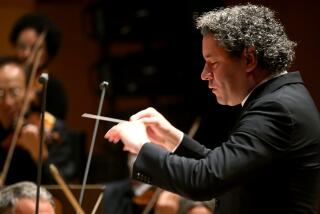Look ma, no hands (or pianist, either)
- Share via
The humble player piano -- the vehicle for the crazy, inspired musical organisms of the late Conlon Nancarrow -- has long since given way to analog and digital instruments and devices. Yet that didn’t stop USC composer Veronika Krausas, who upon receiving a gift of a player piano, strove to reinvigorate the Nancarrow tradition by commissioning a plethora of pieces for her new toy.
Apparently, though, someone thought that Krausas’ instrument and the 23 commissioned pieces would not be enough to hold our attention Tuesday night in USC’s Alfred Newman Recital Hall. So “The Player Piano Project” became a little show, uneasily juxtaposing often complex avant-garde sounds with the old-timey atmosphere that player pianos evoke in pizza parlors.
Two acrobats, Cirque du Soleil alumni Sebastien Stella and Katia Sereno, changed the piano rolls and entertained with their infinitely flexible contortions and deadpan glances. Some of the pieces served as random soundtracks to retro-styled, black-and-white silent film clips by Nana Tchitchoua and Daniel Corral (Corral also contributed one piece and a music box installation in the lobby). At infrequent times between selections, a so-so bluegrass/folk group, Ed Glass and the Windowpanes, briefly jammed.
This stuff had its charms-- and it was almost enough to distract one from the realization that the pieces were mostly dabblings in an unfamiliar medium. Some rattled around abstractly and aimlessly. Some came to an inconclusive halt within seconds. Most drew heavily from the vocabularies of Minimalism and Nancarrow.
To these ears, the most successful were those grounded in tight structures. James Tenney’s “Spectral Canon for Conlon Nancarrow” was a gradual progression from one note to a busy cacophony, all based upon a drone. Marc Sabat’s “Wake for Jim,” the sole piece that required a human (pianist Andrew Goldman struck the extreme bass and treble notes beyond the roll’s reach), swept gradually up the keyboard, came to a dead stop, then swept symmetrically downward. In Corral’s “Eraser,” the piano itself was the star; the geometric, intersecting patterns on the paper roll as the keys rippled right and left was fascinating -- true eye music.
Ultimately, the close of each half fell back on a fail-safe tactic: Leave ‘em with a tune. Which is exactly what Krausas’ splattering extrapolation from Earl Hines’ “Boogie Woogie on St. Louis Blues” (“Blue”) and Ceiri Torjussen’s abstraction of John Williams’ “Raiders March” did. You could hear the humming all the way to the car.
More to Read
The biggest entertainment stories
Get our big stories about Hollywood, film, television, music, arts, culture and more right in your inbox as soon as they publish.
You may occasionally receive promotional content from the Los Angeles Times.










